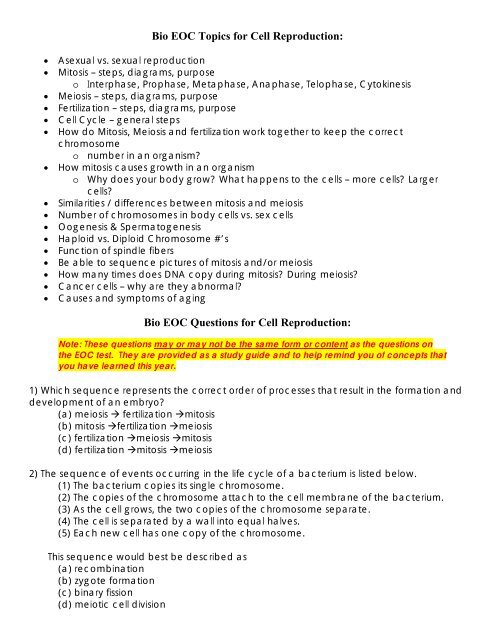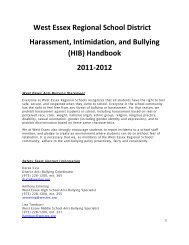Unit 5 Cell Reproduction
Unit 5 Cell Reproduction
Unit 5 Cell Reproduction
You also want an ePaper? Increase the reach of your titles
YUMPU automatically turns print PDFs into web optimized ePapers that Google loves.
Bio EOC Topics for <strong>Cell</strong> <strong>Reproduction</strong>:• Asexual vs. sexual reproduction• Mitosis – steps, diagrams, purposeo Interphase, Prophase, Metaphase, Anaphase, Telophase, Cytokinesis• Meiosis – steps, diagrams, purpose• Fertilization – steps, diagrams, purpose• <strong>Cell</strong> Cycle – general steps• How do Mitosis, Meiosis and fertilization work together to keep the correctchromosomeo number in an organism?• How mitosis causes growth in an organismo Why does your body grow? What happens to the cells – more cells? Largercells?• Similarities / differences between mitosis and meiosis• Number of chromosomes in body cells vs. sex cells• Oogenesis & Spermatogenesis• Haploid vs. Diploid Chromosome #’s• Function of spindle fibers• Be able to sequence pictures of mitosis and/or meiosis• How many times does DNA copy during mitosis? During meiosis?• Cancer cells – why are they abnormal?• Causes and symptoms of agingBio EOC Questions for <strong>Cell</strong> <strong>Reproduction</strong>:Note: These questions Umay or may not be the same form or contentU as the questions onthe EOC test. They are provided as a study guide and to help remind you of concepts thatyou have learned this year.1) Which sequence represents the correct order of processes that result in the formation anddevelopment of an embryo?(a) meiosis fertilization mitosis(b) mitosis fertilization meiosis(c) fertilization meiosis mitosis(d) fertilization mitosis meiosis2) The sequence of events occurring in the life cycle of a bacterium is listed below.(1) The bacterium copies its single chromosome.(2) The copies of the chromosome attach to the cell membrane of the bacterium.(3) As the cell grows, the two copies of the chromosome separate.(4) The cell is separated by a wall into equal halves.(5) Each new cell has one copy of the chromosome.This sequence would best be described as(a) recombination(b) zygote formation(c) binary fission(d) meiotic cell division
3) Which cell is normally produced as a direct result of meiosis?(a) a uterine cell having half the normal species number of chromosomes(b) an egg having the full species number of chromosomes(c) a zygote having the full species number of chromosomes(d) a sperm having half the normal species number of chromosomes4)5) A yeast cell is in the process of budding, a form of asexual reproduction. Which statementdescribes the outcome of this process?(a) The bud will develop into a zygote.(b) The two cells that result will each contain half the species number of chromosomes.(c) The two cells that result will have identical DNA.(d) The bud will start to divide by the process of meiotic cell division.6) Even though each body cell in an individual contains the same DNA, the functions ofmuscle cells and liver cells are not the same because(a) mutations usually occur in genes when muscle cells divide(b) liver tissue develops before muscle tissue(c) liver cells produce more oxygen than muscle cells(d) liver cells use different genes than muscle cells7) Tissues develop from a zygote as a direct result of the processes of(a) fertilization and meiosis(b) fertilization and differentiation(c) mitosis and meiosis(d) mitosis and differentiation8) Variation in the offspring of sexually reproducing organisms is the direct result of(a) sorting and recombining of genes(b) replication and cloning(c) the need to adapt and maintain homeostasis(d) overproduction of offspring and competition
9) The least genetic variation will probably be found in the offspring of organisms thatreproduce using(a) mitosis to produce a larger population(b) meiosis to produce gametes(c) fusion of eggs and sperm to produce zygotes(d) internal fertilization to produce an embryo10)11) A basketball player develops speed and power as a result of practice. This athletic abilitywill not be passed on to her offspring because(a) muscle cells do not carry genetic information(b) mutations that occur in body cells are not inherited(c) gametes do not carry complete sets of genetic information(d) base sequences in DNA are not affected by this activity12) Which of the following is a similarity between the two homologs? (fill in all that apply)a. They both have the same centromere positionb. They have the same nucleotide sequences at all points on the chromosomec. They both have genes that code for the same traits (ex. eyecolor)d. They both are the same size13) This is the form DNA takes when it is highly condensed and tightly coiled around proteinsa. chromatin b. histone c. centromere d. chromosome
14) This is the longest phase: when chromosomes appear, the centrioles separate, and thespindle fibers begin to form.a. metaphase b. anaphase c. prophase d. telophase15) This event UDOES NOTU take place during telophasea. The chromosomes begin to uncoil.b. The nuclear membrane begins to disappear.c. The spindle fibers begin to break apart.d. The nuclear membrane begins to reform.Answers: 1) a, 2) c, 3) d, 4) 1, 5) c, 6) d, 7) d, 8)a, 9) a, 10) 3, 11) d,12) a, c, d, 13) d, 14) c, 15) bBio EOC Topics for Genetics:• Define “genetics” – (the study of what?)• Gregor Mendel – father of Genetics (be able to summarize his work with pea plants)• Define and give examples for the following terms: Genotype, Phenotype, Dominant,o Recesssive, Homozygous, Heterozygous, Purebred, Hybrid• Punnett squareso be able to do punnett squareso what do letters on outside vs. inside the square represent?o Heterozygous (hybrid),pure (homozygous) dominant,pure(homozygous)recessiveo be able to use punnett squares to predict offspring or figure out parentso to predict chances of having a boy or girl• Human Traitso dominant: examples include free earlobes, dimples, widow's peako recessive: examples include attached earlobes, no dimples, smooth hairline• Geneso body cells (2 of each gene); sex cells (1 of each gene)o dominant vs. recessive (incl. punnett squares)o incomplete dominance (incl. punnett squares)o genes on X chromosome (ex, color blindness) (incl. punnett squares)• Amniocentesis, Genetic Counseling, Placenta Sampling• Sex Chromosomes - male XY, female XX (23PrdP pair)• Autosomes vs. Sex Chromosomes• Diseases: down’s syndrome, hemophilia, color blindness, cystic fibrosis,• What does it mean if we say someone is a “carrier” for a disease?• Identify the relationship between the following terms: cell, nucleus, chromosomes,o genes, DNA
Bio EOC Questions for Genetics:Note: These questions may or may not be the same form or content as the questions onthe EOC test. They are provided as a study guide and to help remind you of concepts thatyou have learned this year.1) The transfer of genes from parents to their offspring is known as(a) differentiation (c) immunity(b) heredity (d) evolution2) A child has brown hair and brown eyes. His father has brown hair and blue eyes. Hismother has red hair and brown eyes. The best explanation for the child having brown hairand brown eyes is that(a) a gene mutation occurred that resulted in brown hair and brown eyes(b) gene expression must change in each generation so evolution can occur(c) the child received genetic information from each parent(d) cells from his mother’s eyes were present in the fertilized egg3) Viruses frequently infect bacteria and insert new genes into the genetic material of thebacteria. When these infected bacteria reproduce asexually, which genes would most likelybe passed on?(a) only the new genes(b) only the original genes(c) both the original and the new genes(d) neither the original nor the new genes4) A mutation changes a gene in a cell in the stomach of an organism. This mutation couldcause a change in(a) both the organism and its offspring(b) the organism, but not its offspring(c) its offspring, but not the organism itself(d) neither the organism nor its offspring5) Which statement best explains the observation that clones produced from the sameorganism may not be identical?(a) Events in meiosis result in variation.(b) Gene expression can be influenced by the environment.(c) Differentiated cells have different genes.(d) Half the genetic information in offspring comes from each parent.6) The Law of Dominance and Recessiveness states that, if alleles in a gene pair differ, theform of the trait expressed isa) recessiveb) hybridc) hiddend) dominant
7) The Law of Segregation states that, during meiosis I, each pair of allelesin a gene paira) is transferred to the same gamete.b) separate, such that each gamete receives only one allele fromthe pair.c) is transferred to the zygote.d) separate so that the sperm and egg receive both copies of thegene pair.8) The probability that the first baby born in a family is a boy is______________.The probability that the first and second babies will be boys is___________.a) 50 : 100 b) 50 : 25 c) 25 : 50 d) 25 :259) Gene pairs are located ona) homologous chromosomes b) sister chromatids c) sexchromosomes only10) A gene pair can containa) two dominant allelesb) two recessive allelesc) a dominant and a recessive alleled) any of these11) Which of the following shows a cross involving two pure bred parents?a) YY x yy b) Nn x Nn c) ZZ x Zz d) Rr x rr12) A marshmalien (imaginary organism) is homozygous recessive for twobody segments as opposed to the dominant trait which is three bodysegments. What is the probability that an egg cell formed from this parentwill contain an allele for two body segments?a) 0% b) 1:4 c) ½ d) 3:1 e) 100%13) What is the probability that a heterozygous parent will produce agamete with the dominant allele for the trait?a) 0% b) 1:4 c) 1/2 d) 100%14) Only one of two children in a family expresses the recessive trait fordeafness (t). Which of the following could be the genotypes of thechildrens’ parents?a) TT x Tt b) Tt x Tt c) TT x tt d) tt x tt
15) A sperm cell containing a single Y chromosome can help producea) only a male offspring b) only a female offspringc) either male or female offspringAnswers: 1) b, 2) c, 3) c, 4) b, 5) b, 6) d, 7) b, 8) b, 9) a, 10) d, 11) a, 12) e,13) c, 14) b, 15)
















